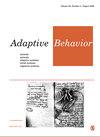Reinforcement learning-based aggregation for robot swarms
IF 1.3
4区 计算机科学
Q4 COMPUTER SCIENCE, ARTIFICIAL INTELLIGENCE
引用次数: 0
Abstract
Aggregation, the gathering of individuals into a single group as observed in animals such as birds, bees, and amoeba, is known to provide protection against predators or resistance to adverse environmental conditions for the whole. Cue-based aggregation, where environmental cues determine the location of aggregation, is known to be challenging when the swarm density is low. Here, we propose a novel aggregation method applicable to real robots in low-density swarms. Previously, Landmark-Based Aggregation (LBA) method had used odometric dead-reckoning coupled with visual landmarks and yielded better aggregation in low-density swarms. However, the method’s performance was affected adversely by odometry drift, jeopardizing its application in real-world scenarios. In this article, a novel Reinforcement Learning-based Aggregation method, RLA, is proposed to increase aggregation robustness, thus making aggregation possible for real robots in low-density swarm settings. Systematic experiments conducted in a kinematic-based simulator and on real robots have shown that the RLA method yielded larger aggregates, is more robust to odometry noise than the LBA method, and adapts better to environmental changes while not being sensitive to parameter tuning, making it better deployable under real-world conditions.基于强化学习的机器人群体聚合
在鸟类、蜜蜂和阿米巴虫等动物中观察到的个体聚集成一个群体的现象,众所周知,这种聚集可以保护整个群体免受捕食者的侵害,或抵抗不利的环境条件。众所周知,当蜂群密度较低时,环境线索决定聚集位置的基于线索的聚集是具有挑战性的。在此,我们提出了一种适用于真实机器人在低密度群体中的聚合方法。在此之前,基于地标的聚集(Landmark-Based Aggregation, LBA)方法使用里程航位推算和视觉地标相结合的方法,在低密度群体中获得了更好的聚集效果。然而,该方法的性能受到里程计漂移的不利影响,危及其在实际场景中的应用。本文提出了一种新的基于强化学习的聚合方法RLA,以提高聚合的鲁棒性,从而使真实机器人在低密度群体环境下进行聚合成为可能。在基于运动学的模拟器和真实机器人上进行的系统实验表明,与LBA方法相比,RLA方法产生了更大的聚合,对里程噪声更具鲁棒性,并且更好地适应环境变化,同时对参数调整不敏感,使其在现实条件下更好地部署。
本文章由计算机程序翻译,如有差异,请以英文原文为准。
求助全文
约1分钟内获得全文
求助全文
来源期刊

Adaptive Behavior
工程技术-计算机:人工智能
CiteScore
4.30
自引率
18.80%
发文量
34
审稿时长
>12 weeks
期刊介绍:
_Adaptive Behavior_ publishes articles on adaptive behaviour in living organisms and autonomous artificial systems. The official journal of the _International Society of Adaptive Behavior_, _Adaptive Behavior_, addresses topics such as perception and motor control, embodied cognition, learning and evolution, neural mechanisms, artificial intelligence, behavioral sequences, motivation and emotion, characterization of environments, decision making, collective and social behavior, navigation, foraging, communication and signalling.
Print ISSN: 1059-7123
 求助内容:
求助内容: 应助结果提醒方式:
应助结果提醒方式:


